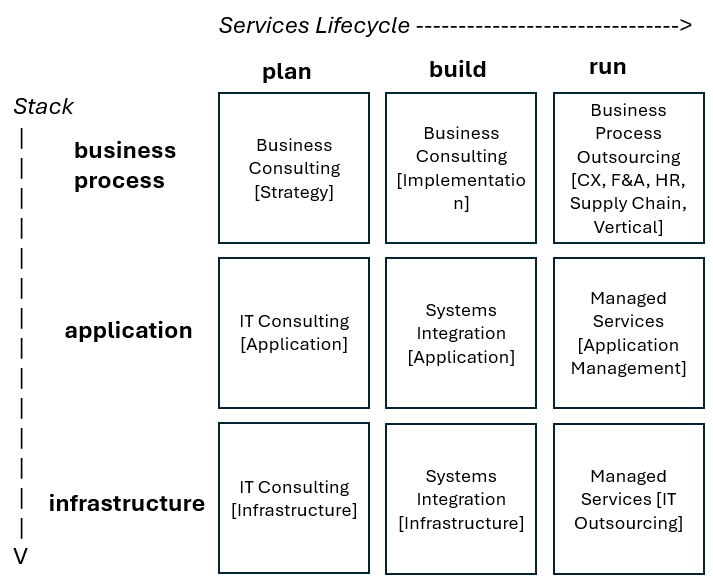9 Business and Technology Services Markets
The services market can be segmented into 9 markets based upon two axes:
- The Services Lifecycle Axis:
- Plan services focus on the strategic and preparatory aspects of IT projects. These services are essential for setting the foundation and direction for IT initiatives:
- Strategic Planning: Developing long-term IT strategies aligned with business goals
- IT Road mapping: Creating detailed plans for technology adoption and implementation over time
- Requirements Analysis: Identifying and documenting the needs and expectations of stakeholders
- Feasibility Studies: Assessing the viability and potential impact of proposed IT projects
- Risk Management: Identifying, analyzing, and mitigating risks associated with IT initiatives
- Budgeting and Forecasting: Estimating costs and financial planning for IT projects
- Build services are concerned with the actual creation and development of IT solutions. These services involve the design, development, and deployment of IT systems and applications:
- System Design: Architecting IT systems and solutions based on requirements
- Application Development: Coding and building software applications
- Infrastructure Setup: Installing and configuring hardware, networks, and other infrastructure components
- Integration Services: Ensuring different IT systems and applications work together seamlessly
- Testing and Quality Assurance: Verifying that IT solutions meet specified requirements and are free of defects
- Deployment and Implementation: Rolling out new systems and applications to the production environment
- Run services focus on the ongoing operation, maintenance, and support of IT systems. These services ensure that IT solutions continue to function effectively and efficiently:
- System Monitoring: Continuously tracking the performance and health of IT systems
- Maintenance and Updates: Applying patches, updates, and upgrades to keep systems current
- Technical Support: Providing assistance and troubleshooting for end-users and IT staff
- Incident Management: Responding to and resolving IT issues and outages
- Service Management: Managing IT services to ensure they meet agreed-upon service levels
- Performance Optimization: Improving the efficiency and performance of IT systems
- Infrastructure services focus on the foundational hardware and software systems that support IT operations. These services ensure that the underlying technology environment is robust, secure, and scalable:
- Cloud Services: Provisioning and managing cloud infrastructure, including IaaS, PaaS, and SaaS solutions.
Security Management: Implementing and maintaining security measures to protect infrastructure from threats - Data Center Operations: Overseeing the physical and environmental aspects of data centers, including power, cooling, and security
- Server Management: Installation, configuration, and upkeep of physical and virtual servers.
Storage Solutions: Management of data storage systems, including SAN, NAS, and cloud storage - Network Management: Design, implementation, and maintenance of network systems, including LAN, WAN, and wireless networks
- Cloud Services: Provisioning and managing cloud infrastructure, including IaaS, PaaS, and SaaS solutions.
- Application services focus on the development, deployment, and maintenance of software applications that support business operations. These services ensure that applications are functional, efficient, and aligned with business needs:
- Software Development: Creating custom software applications tailored to specific business requirements
- Application Integration: Ensuring new applications work seamlessly with existing systems
- Testing and Quality Assurance: Verifying that applications meet specified requirements and are free of defects.
- Deployment and Implementation: Rolling out new applications to the production environment
- Application Support and Maintenance: Providing ongoing support and updates to ensure applications remain functional and up-to-date
- User Training and Documentation: Educating users on how to effectively use new applications and providing comprehensive documentation
- Business process services focus on the optimization and management of business processes through IT solutions. These services ensure that business operations are efficient, effective, and aligned with organizational goals:
- Process Mapping and Analysis: Documenting and analyzing current business processes to identify areas for improvement
- Workflow Automation: Implementing IT solutions to automate repetitive and manual tasks
Business Process Reengineering: Redesigning business processes to enhance efficiency and effectiveness
Performance Monitoring and Reporting: Continuously tracking the performance of business processes and generating reports - Compliance Management: Ensuring business processes adhere to regulatory and organizational standards
- Change Management: Developing strategies to manage the impact of process changes on the organization
- Plan services focus on the strategic and preparatory aspects of IT projects. These services are essential for setting the foundation and direction for IT initiatives:


